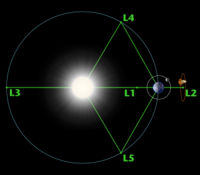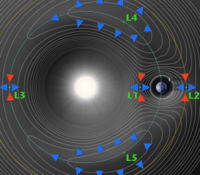Solar Power
An attractive source for power on the Moon is the Sun. Solar is particularly inviting in the polar regions where mountain tops are available that have solar views 75% to 99% of the time. The sun light is not diminished by an atmosphere and is never blocked by clouds. It is harsh and unrelenting.
From the surface of the Moon, the Sun appears to move slowly across the sky making a full cycle every 29 days. On rare occasions it is eclipsed by the Earth for a few minutes.
During the local summer at the poles, the Sun simply circles the sky very near the horizon. Occasionally, it may be blocked by mountain tops or local instillations such as other power collectors. During the dark local winter at the poles, a sunlit region is never more than 30 miles away and those special sunlit mountain tops are much closer.
Near the lunar equator, the Sun is visible only one half the time. The 14 day lunar nights are a major problem for power generation and are a major factor in setting a polar location for the first lunar settlement.
There are basically two types of solar power, Solar Dynamic (SD) and Photovoltaic (PV).
SD uses a heat cycle to drive a piston or a turbine which connects to a generator or dynamo. Two popular cycles for Solar Dynamic are Brayton Cycle or Stirling Cycle. Solar Dynamic systems employ a large reflector to focus sunlight to a high concentration to achieve a high temperature for the heat cycle to operate at highest possible efficiency.
PV uses semiconductors (e.g. Silicon or Gallium Arsenide) to directly convert sunlight photons into electric potential. Commonly know as “Solar cells”
Contents
Comparison of PV versus SD
PV Problems
The main problem with solar power is that Photovoltaic conversion efficiency is only about 15-20% efficient (for lower-cost single juntion cell technologies), and 25-30% efficient (for higher-priced multijunction PV cells). While on a power per unit mass (specific power) basis, photovoltaic cells are one of the lowest-mass power supplies avalable, PV cells are nevertheless rather heavy to ship from Earth and to soft land on Luna is very expensive.
SD Problems
SD has a much more severe pointing requirement than PV because it needs to maintain an accurate optical focus.
If a PV array drifts off a few degrees, the power level drops a few percent.
If a SD array drifts off a few degrees, the power level drops off to zero.
Space Based Solar power
Until ISRU manufacturing is online, Solar Power Satellites (SPS) represent a more economic means of supplying large scale basebar power on the Moon in the early days.
Compared to PV or SD systems, an SPS rectenna by itself is lightweight and has a conversion efficiency of over 90%.
Let us assume a PV array is 10 times heavier per watt than a rectenna.
That means we can get 5*10 = 50 times as much power per kilogram for a rectenna than for a PV array. That means a rectenna will be at least 50 times cheaper per watt of useful power than PV array. "At least" because the manufacturing cost of a rectenna will be much cheaper than for PV array.
Soft landing hardware on to the Moon is very expensive, so weight is at a premium.
Hence space based solar power is attractive, where the PV (or SD) array remains in orbit, and a recetenna or receiver is soft landed on to the surface of the Moon.
Two different orbital locations have been studied
Option 1) Located at Lagrange Libration points
The distance from L1 to Luna is about the same as the distance from Earth to a geostationary satellite.
So one could put an SPS at lunar-L1 and beam microwaves from there to supply one or more rectennas on the Moon as a very efficient way to provide energy to a power hungry moon base.
The sun angle across PV arrays on the lunar surface constantly changes, and is usually less than the 1,360 w/m^2. To maintain constant max power the PV array must have expensive and heavy steering equipment. Whereas a rectenna does not need to be steered, and always gets maximum power.
The ideal site for the lunar rectenna would be in Sinus Medii at the Lunar 0-Longitude point on the Lunar Equator, in the middle of the side which faces the Earth.
1) Because it is directly below the L-1 point, 2) it is the closest point on the lunar surface to the L-1 point, 3) Because at that point the lunar surface is at right angles to the incoming microwave beam.
All these factors permit the smallest rectenna at that location.
Without making any modifications at all to that very SPS, it could easily be maneuvered from L1 to GEO to feed a terrestrial ground based rectenna. The antenna design for L-1 to Luna will work equally well from GEO to Earth
Option 2) Molniya Satellites
This option would be to have a large constellation of several Molniya type low orbiting power satellites in elliptical polar orbits.
At the 2007 Rutgers Symposium, Brandhorst et al[1][2] proposed beaming power to the lunar surface using lasers from lunar satellites in Molniya orbits.
Lasers versus Microwaves
The ideal frequency to use for lunar power beaming has not been definitively established. Microwave frequencies of 2Ghz and 5GHz have been proposed. But lasers are an alternative. In the lunar environment it is a vacuum, so absorption by atmospheric water vapor and other gases are not a factor, allowing greater choice of frequencies than for beaming power down to Earth.
Pros and cons:
Rectenna versus PV array
Microwave rectenna converts microwave to DC at about 90% efficiency, compared to about 50% efficiency for PV conversion of laser to DC.
IMHO you've got the right anwser!
Thermal Problems
The laser method suffers from major thermal problems versus microwave. Rejecting the large amount of waste heat will require large heavy thermal radiators which will add significantly to the launch costs.
Transmitter Antenna Problems
Microwave antenna, depending on frequency, will need very large aperture transmitter antenna, and even larger diameter rectenna array. A laser would be much smaller and more compact, and so would the receiving PV array
Overall Comparison
At this time no definitive work has been published to show whether the larger radiators of the laser system would outweigh the larger antennas of the microwave system.
Lunar Solar power
Once lunar development is under way, one potential major lunar export could be lunar-produced energy. With in-situ manufactured solar panels on the lunar surface, more power could easily be produced than is needed for lunar activities; this power could be beamed via microwave or laser systems to where it's needed in near-Earth space, or to Earth itself. Such a system has been described in detail by David Criswell as the solution to Earth's future energy problems.
Advantages of the Lunar Solar Power System:
- No need to launch massive solar panels into orbit from Earth or Moon once the initial lunar manufacturing is established; only minimal launch requirements to build the system out.
- Provides stable base line for synchronizing and precisely targeting power beams
- All the usual advantages of solar power satellites, over normal Earth sources of energy
Disadvantages:
- the lunar surface rotates under the Sun, just as Earth does, so the LSP solar panels would only be in sunlight for half the lunar month.
- significant technology development is needed on automating production of solar panels from lunar soil, and related space manufacturing issues.
References
- ↑ A Solar Electric Propulsion Mission with Lunar Power Beaming.Henry W. Brandhorst, Jr., Julie A. Rodiek and Michael S. Crumpler ...
- ↑ A Solar Electric Propulsion Mission with Lunar Power Beaming. 36, 23, Rodiek et al...
| Work on this article has outpaced copyediting on it. You can help Lunarpedia by formatting, editing, or tidying it. |








